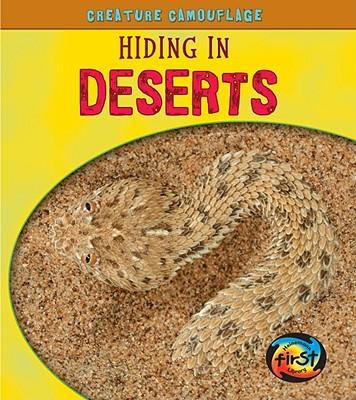Overview
What would be the best way for an animal to hide in the desert? To look like the desert! This title introduces readers to desert habitats and the animals that live and survive there using camouflage. Readers will discover what physical traits enable these animals to blend into their surroundings so they can hide from predators.
Full Product Details
Author: Deborah Underwood
Publisher: Capstone Press
Imprint: Capstone Press
Dimensions:
Width: 19.50cm
, Height: 0.30cm
, Length: 21.40cm
Weight: 0.113kg
ISBN: 9781432940300
ISBN 10: 1432940309
Pages: 32
Publication Date: 01 September 2010
Recommended Age: From 5 to 7 years
Audience:
Children/juvenile
,
Children / Juvenile
Format: Paperback
Publisher's Status: Active
Availability: In Print

This item will be ordered in for you from one of our suppliers. Upon receipt, we will promptly dispatch it out to you. For in store availability, please contact us.
Reviews
Camouflage and habitats are seen in a different and exciting way through this new series. Each book has large font and minimal text with a large color photograph on each page. The series' unique perspective uses photographs of an animal in hiding. The next page then shows the same picture with the camouflaged animal highlighted so the reader can see it. Each title also covers several animals that stand out instead of needing to blend in with their surroundings. Younger students will love these books, not only for the interesting facts and the way they are presented, but for the I-Spy-like photographs. These books are a fun way to learn about the creatures who use camouflage to survive; perfect for animal projects and the study of animal habitats. A simple contents page make this a winner for an introductory lesson for younger students. Glossary. Index. - Maureen Mooney, Library Media Specialist, Caroline St. School, Saratoga Springs, New York Library Media Connection January/February 2011-- Library Media Connection This book provides information on adaptations that go beyond mere camoflauge. As part of a series of primary leveled readers, it is a valuable resource for teaching the concept. Each of the eight books in the series highlights a different ecosystem and the animals adapted to thrive in it. Because all the books in the series use the same format, navigating them is easy. In this volume, early readers learn how camouflage helps a desert animal. It begins with a definition of a desert (a large area of dry land). Students may not be familiar with some of the animals depicted, such as the dwarf puff adder or the meerkats. The dwarf puff is memorable, with eyes at the top of its head, half hidden in the sand, and ready pounce. The meerkats look like soldiers standing at attention to alert one another of a potential predator. Some of the hidden creatures will have teachers squinting at the pages for identification! This book is not a substitute for taking young learners outside into their local environment looking for adaptations of animals and plants. It does, however, open the door to understanding that animals all over the world must adapt to survive in their ecosystems. Strategies are used to help young students read and understand the book and help primary teachers. Each page has one to three sentences in a large black print appropriate for primary students, and there is a contrasting explanation box overlapping every photo. Page numbers are highly visible for use with groups of students, and science terms that may challenge a student's reading level are accompanied by phonetic spelling. Highlighted glossary terms are limited to 11, ensuring that younger students won't be overwhelmed and can focus on those that are relevant. Camouflaged animals are expertly hidden in photos and uniquely revealed. An identical photo is on the next page, depicting the animal against a contrasting gray-and-white background. This will help even the youngest students to distinguish the animal's physical characteristics. Giving students enough time to examine the photographs may tempt them to turn the page to find the animal revealed. Each book in this series explains a unique ecosystem and highlights animals that have adapted to that environment. The entire series helps students to understand the importance of adaptation to an animal's survival in diverse ecosystems. - Karen Timmons NSTA Recommends 12/16/2010-- NSTA Recommends Using a bit of photo-magic to help viewers understand how camouflage works, each volume features eight paired views of an animal-one in saturated but close to natural color, the other (seen with a turn of the page) showing it as before but with all the surrounding vegetation or ground converted to neutral shades. The trick doesn't work well in some of the shots in Polar Regions (snow is snow, after all), and many the photos are so close-up that the animals aren't all that hidden-but it's still a neat idea. Sandwiched between introductory capsule descriptions of each habitat and the adaptations that natural residents have made, and closing spreads on wildlife with coloration that's intended to stand out rather than conceal, the picture galleries provide unusual support for a range of natural-science interests. -John Peters, formerly at New York Public Library School Library Journal November 2010-- School Library Journal




